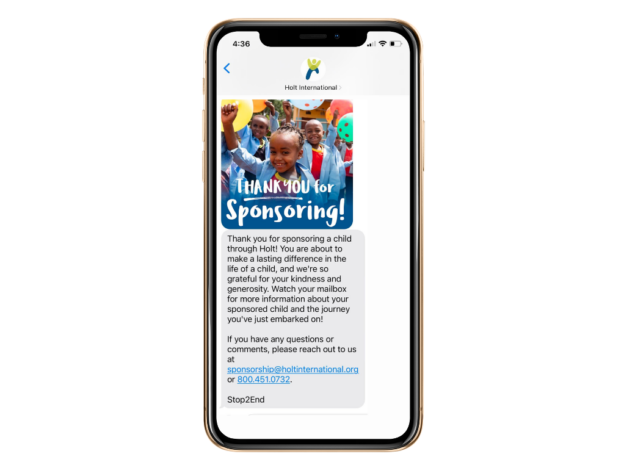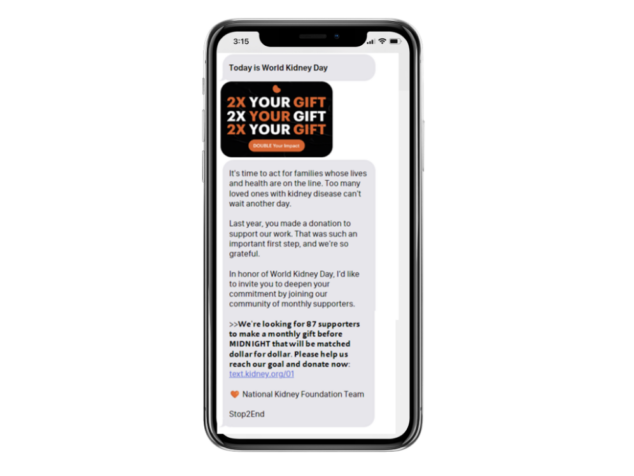5 Reasons Text Messaging Should Be in Every Fundraiser’s Toolbox

As fundraising professionals, we know that no single channel can carry the full weight of donor engagement. Success lies in multichannel engagement—email, social media, direct mail, events, peer-to-peer and, increasingly, text messaging.
According to the 2025 M+R Benchmarks Report, text messaging has officially earned its place in the nonprofit marketer’s toolbox. Far from replacing traditional channels, texting (sometimes called mobile messaging) enhances campaign reach, timing, and personalization in a way that’s hard to match.
Here are five data-backed reasons why every nonprofit should be using text messaging to complement their broader fundraising strategies.
1. Texting Is Growing—and So Are Its Results
The latest M+R data is clear: Mobile messaging is on the rise. In 2024, nonprofits sent 31% more texts than the previous year. That increase paid off: Texting revenue jumped by 37%, and conversion rates also increased.
In contrast, email—though still a core channel—experienced an 11% decline in revenue and a 15% drop in response rate over the same period.
Rather than replacing email, the most successful nonprofits are integrating texting with it. They’re using timely, complementary text messages, often sent in the evening after emails go out, to reinforce calls to action and increase conversion when donors are most likely to engage. It’s not either/or. It’s smarter integration across channels.
2. It’s Not Just for Fundraising
Text messaging may be powerful for appeals, but its real strength is engagement. According to the Nonprofit Text Messaging Insights Report, just over half (52%) of texts sent by nonprofits are fundraising-related. The rest are cultivation, engagement, event reminders, volunteer asks, and advocacy calls to action.
That’s echoed in the M+R report, which found that 50% of nonprofits use texting for fundraising, but nearly as many use it for cultivation (50%), event promotion (47%), advocacy (47%), and volunteer recruitment (44%).
The takeaway? Mobile messaging builds relationships. By mixing appeal messages with value-driven engagement, nonprofits can drive stronger donor retention and response over time, without burning out their lists.

3. Donors Respond When Texts Arrive at Key Giving Moments
Just like other channels, texting thrives when urgency and timeliness matter. According to M+R, nonprofits sent 2–3 more texts in December 2024 than in other months. This increase is mirrored in the Nonprofit Text Messaging Insights Report, which also showed increases in texts sent in November and December.
GivingTuesday, giving days, important campaigns, and emergencies are all moments when a well-timed text can make the difference between a glance and a gift. With 90% of texts opened within three minutes, mobile messaging provides nonprofits an instant way to engage supporters during critical giving moments and to see immediate responses.

4. It’s Cost-Effective Compared to Other Paid Channels
Text messaging was included in M+R’s advertising section for the first time and the results were eye-opening: Texting had the second-lowest cost per donation at $62, just behind search ads ($61).
For nonprofits weighing their acquisition or reactivation strategies, texting offers a low-cost, high-impact channel to reach donors, particularly those who have lapsed or are less responsive via email or social.
When making the case to launch or expand a text messaging program internally, comparing its cost efficiency to other paid media channels can be a compelling argument for growth.
5. Nonprofits Are Investing in Texting and Seeing Returns
Investing in text messaging grew 75% year-over-year in 2024, making it one of the fastest-growing channels in nonprofit marketing, surpassed only by multichannel ads and connected TV.
And that investment is translating to results. As budgets for texting increased, so did the volume of messages sent, as did conversion rates, and overall revenue. For nonprofits that haven’t fully adopted text messaging, recent trends make a strong case for giving mobile messaging a more prominent place in their communication mix.
Final Thoughts: It’s Time to Start Texting
Mobile messaging is fast, personal, and increasingly expected by donors across generations. One of texting’s greatest strengths is its immediacy. Whether you’re sending an urgent appeal, a heartfelt thank-you note, or a quick event reminder, it delivers a real-time connection.
Texting doesn’t replace email, direct mail, or social media—it enhances them. When used strategically and thoughtfully, it can lift your campaigns, build stronger donor relationships, and help you raise more with greater efficiency.
If texting isn’t in your nonprofit’s toolbox yet, now’s the time to add it.
